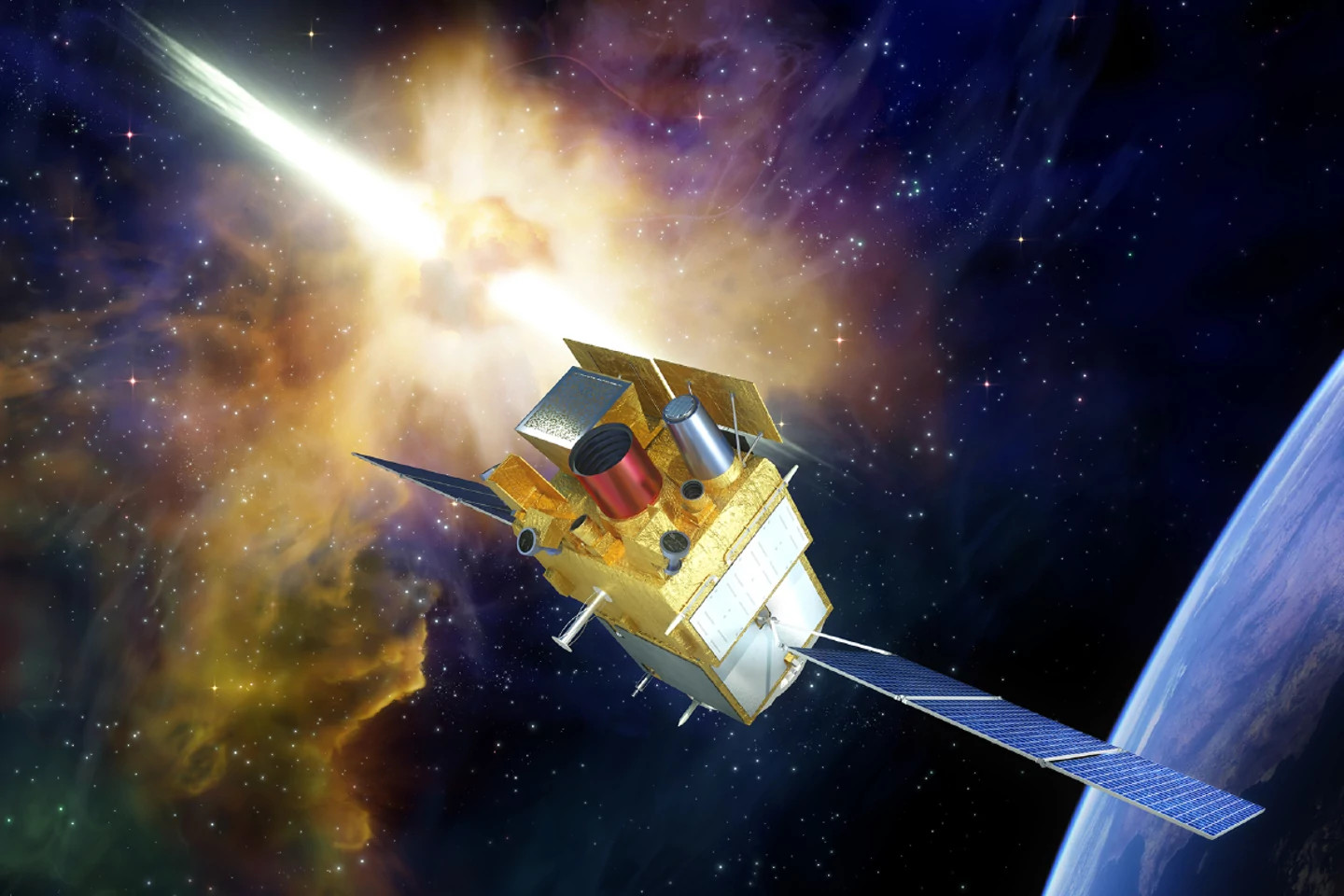SVOM mission to study the most distant stellar explosions enters operational phase
The verification phase of this Franco-Chinese space mission, dedicated in particular to the detection and study of gamma-ray bursts, has come to an end with highly promising initial results. SVOM (Space-based multi-band astronomical Variable Objects Monitor) is the fruit of collaboration between two national space agencies, the China National Space Administration (CNSA) and CNES, with major contributions from CEA and CNRS in France.
Nine months after the satellite’s launch from the Xichang launch base (China), the satellite and system verification phase was completed at a review in Beijing in January 2025. This phase demonstrated that the SVOM system, satellite, instruments and operational centers are operating smoothly, meeting the requirements of such a complex mission. All SVOM instruments are fully satisfactory, meeting the specified performance levels. The Franco-Chinese Joint Steering Committee for the project was held on April 23 in Shanghai, officially endorsing the transition of the SVOM project from the validation phase to the operational phase, for a nominal duration of 3 years and more if possible.

Over 100 gamma-ray bursts already detected
More than 100 gamma-ray bursts, the most energetic phenomena in the Universe, have already been detected by SVOM to date. Among them, at the end of March 2025, SVOM detected a faint burst that turned out to be the third-most distant gamma-ray burst ever detected since the first distance determined for a gamma-ray burst, more than 25 years ago. This burst took place when the Universe was only 729 million years old. In early October 2024, another, closer, was deemed interesting enough to be observed urgently by the JWST. These first exceptional results were presented by the two French and Chinese PIs (Principal Investigators) at the opening ceremony of Space Day of China on April 24, also in Shanghai.
Lasting only a few thousandths of a second, gamma-ray bursts are the result of a colossal release of energy, equivalent to that generated by the Sun over its entire lifetime. Some of these flashes are thought to occur when two neutron stars, or a neutron star and a black hole, orbit each other before coming together and merging. Others are linked to the explosion of very massive stars in distant galaxies. This light was sometimes emitted when our Universe was less than a billion years old. So, before reaching us, the light from these events travels several billion light-years, taking on the imprint of the Universe’s multiple epochs. In other words, studying gamma-ray bursts helps us to better understand the evolution of our Universe.
Two French instruments, ECLAIRs and MXT
But the fleeting nature of gamma-ray bursts makes observing them a highly complex task. During the explosion, this brief, intense gamma-ray burst is generally followed by photon emission at all frequencies of the electromagnetic spectrum, which can be observed for a few hours or days in X-ray or visible light.
To effectively detect and study all phases of this phenomenon, SVOM has four instruments: two designed and built by China (GRM and VT) and two by France: ECLAIRs and MXT. ECLAIRs, a wide-field telescope to detect and locate gamma-ray bursts in the X-ray and gamma-ray energy bands. This wide-field telescope covers one-sixth of the entire sky. MXT is a telescope sensitive to low-energy X-rays, for fine-tuning the location and observation of gamma-ray bursts.
In concrete terms, when a gamma-ray burst is detected by ECLAIRs, the satellite reorients itself in a matter of minutes to aim precisely at the area of the localized event, enabling instruments with a narrow field of view, such as MXT, to observe the burst in turn and provide a more accurate location of the burst. Information on the position of the gamma-ray burst on the sky is also transmitted to the ground in less than a minute, thanks to a network of VHF antennas deployed all around the equator and the tropics, to two watch centers set up in France and China. The latter, aided by ground-based telescopes dedicated to the mission, can then launch further investigations and, if necessary, alert large space and ground-based telescopes so that they too can orient themselves towards the area of sky and observe the gamma-ray burst. The fast Franco-Mexican COLIBRI telescope, 1.3 m in diameter and specially built for the mission, is a major asset for this ground-based tracking system.
The SVOM mission, launch, satellite and operations are under Chinese responsibility. Design and production of the instruments and ground components are shared between China and France. CNES is the mission’s program manager and the project’s technical manager, as well as prime contractor for the ECLAIRs and MXT instruments, in partnership with CEA and CNRS laboratories and their partners, with CEA also assuming scientific responsibility for the project.
Further Resources
- CNRS, CNES and CEA’s Press Release
- Website dedicated to the mission
IRAP Contact
- Olivier Godet, member of the SVOM team at IRAP : olivier.godet@irap.omp.eu






